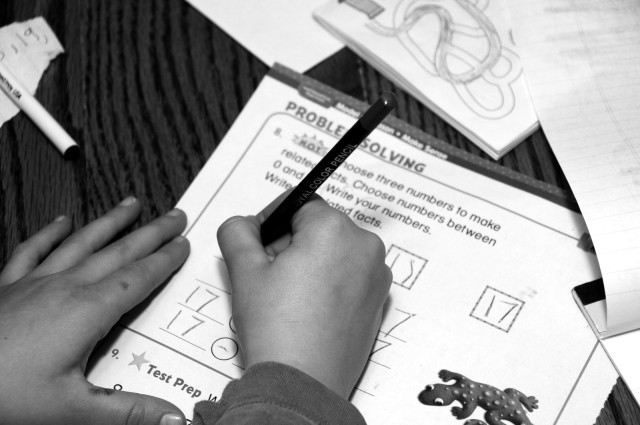Conservatives around the country are expressing dismay at the implementation of the Common Core Standards, a set of educational standards that forty-five states have adopted. Some of the concerns are philosophical-political worries about excessive Federal control, about the perception that the Federal government is taking control of something that should be in the hands of the states. Ironically, one of the ideas conservatives have been pushing for years was a major impetus the adoption of the Common Core Standards (CCS). Conservatives have long wanted performance-based testing as a measure of teacher and school success, and many would love to implement merit-based pay. The logic is simple: the better you teach, the better your students’ test scores should be. There are a whole host of problems with this approach, but I’m not delving into those right now, tempting though it may be. Instead, look at the problem state standards have when used for measuring teacher success:
- States have different standards. That means we’re trying to look at for the same “success” markers through a whole variety of different metrics.
- States have different tests. South Carolina, for instance, is known for having a more difficult test than neighboring states. This means that according to these tests, South Carolina schools are doing worse than its neighbors when in reality it’s just a question of test bias.
The CCS implementation is an attempt to use a uniform measure for all states, simple as that.
More specifically, though, many conservatives have a problem with how they perceive some of the methodologies that the Common Core Standards encourage teachers to implement. For example, the CCS pushes teachers to get students to perform close readings of texts. Wikipedia gives as good a definition of close reading as I’ve ever found:
The careful, sustained interpretation of a brief passage of text. Such a reading places great emphasis on the single particular over the general, paying close attention to individual words, syntax, and the order in which sentences and ideas unfold as they are read.
In other words, students are learning how to pick apart texts word by word, to wrestle with the text on an almost molecular level. The problem? The model lesson included for teaching the Gettysburg Address encouraged teachers to avoid giving much background information.
“How can you teach the Gettysburg Address without background information?!” conservative commentators cried.
“What kind of education is this!?” conservative bloggers moaned.

Yet such an assignment is intended to get students to read to understand for themselves. Historically, teachers have been guilty of giving too much background information, and students can rely on this instead of the text itself. Taking some — and note that by no means did the model lesson say no context should be provided — of that away forces all students to look to the text itself for understanding, not what the teacher provided before reading.
When we turn to math, the situation is similar. Conservative critics bemoan the fact that elementary level math uses terms like “number sentences” and encourages “guess and check.” They eagerly post photos of their children in tears from the difficulty of the homework.
L, of course, is encountering CCS math now, so we’re getting a first-hand view of the supposed horrors, and I have to say so far, I’m impressed. Far from being convoluted and confusing, it seems to me that CCS math concepts teach a fluent understanding of basic mathematical concepts rather than rote memorization of math facts.
One problem that L recently encountered had the following instructions:
Choose three numbers to make related math facts. Choose numbers between 0 and 18. Write your numbers. Write your related facts.
“Math facts” is CCS-speak for equation, but it goes beyond that: it teaches students to see the relationships between the three numbers as a matrix of facts rather than a bunch of randomly memorized equations.

It gets them thinking that if 6 + 11 = 17, then similarly 11 + 6 = 17. It teaches them that they can reverse the numbers and change a sign for another group of facts: 17 – 6 = 11 and 17 – 11 = 6. By drilling students in this kind of thinking, CCS-based math seems to encourage students to think of clumps of math facts and see them as interrelated.
As to the vocabulary, using “number sentence” or “math facts” as opposed to “equation” seems to be merely semantic. They’re all valid descriptors of the same thing.
Here is a recent example of uninformed criticism of “guess and check.”
L has yet to start “guess and check,” but I can already guess about the thinking behind that: it’s an effort to teach children from an early age how to estimate, something that I find with my own students is a skill that is sorely lacking. Granted, I don’t teach math, but I use math in the classroom from time to time. For instance, as we’re nearing the end of the third quarter, we begin informing parents and students who might fail that repeating the eighth grade is an impending danger. To help students who might be facing such a situation calculate how much they need to improve for the fourth quarter, I present them with the following scenario:
In order to pass, you must have an average of 70 for the year, which would also work out to an average of 70 for each quarter. Therefore, you can add those four quarters up to determine how many points you need to pass: 280. Take your first semester grade, multiply it by two, add your third quarter grade, and subtract all that from 280. You’ll come up with your necessary fourth quarter grade.
They look at me like I’m speaking Greek, so we break it down. 280 – (first semester grade * 2 + third quarter grade) – what you need to pass. Then we plug in some hypothetical numbers: 280 – (68 * 2 + 63) = x. “So what’s 68 times 2?” I ask. Blank looks. No one has ever taught them the multiple ways you could estimate this in your head. Indeed, not even estimate: it’s easily calculated. 60 * 2 + 8 * 2, or 120 + 16, or 136. You could also do it with 70 * 2 and then subtract. Either way, you end up with the answer in a matter of moments. Or you just estimate with 70 * 2. Yet for so many students, this is completely foreign thinking. (In the above example, in case you’re curious and not inclined to finish the calculation, the hypothetical student would have to score an 81 for the fourth quarter to pass.)
Common Core math, it seems, is trying to teach students these skills from an early age by getting them to do it all the time. It’s not meant to be a replacement for actually working the problem. Indeed, it’s called “guess and check,” not just “guess.”
For me, as a right-leaning moderate, I find it embarrassing that so many who share some of my other political views can be so very ridiculously uninformed and, quite frankly, can show such a frightening lack of critical thinking. Maybe it would be a good idea for these critics to add “and check” to their own guessing.